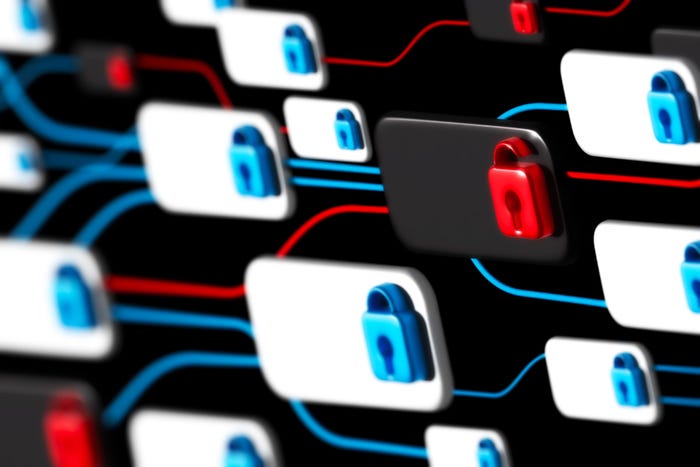The Risks of Using an Unsecured Network and the Best Way to Protect Your Users and Company
IT departments and individual users must practice safe, trusted, and secure Internet habits to avoid the risks of unsecured networks and keep cyber villains out.
March 5, 2024

An unsecured network is a network without security protections. In other words, you don’t need a userID or a password to sign onto an unsecured network. There are no network authorizations for access needed, and there are no built-in security protections to prevent hackers from gaining access to the network. When individuals ask what an unsecured network means, it's also important to note that a totally unsecured network can come in many forms: unsecured Wi-Fi network (aka, Wi-Fi unsecured network), unsecured satellite network or unsecured wired network, to name a few.
When a network is not secured physically or with software that prevents network access from unauthorized users, the network becomes an insecure network that can easily be accessed by outside actors who are not authorized to use the network or who may have the intent to cause immeasurable harm.
What are the dangers of using an unsecured network?
The dangers of using an unsecured network are that outsiders (i.e., individuals not authorized to use the network) can break into the network because the network lacks physical or software-based security and has no way of keeping them out. These bad actors can be from a competing company, or they can be bad actors from the outside who are interested in obtaining your information so they can hold your company hostage to pay for it or sell the stolen information to others.
1. Hackers can access your corporate information
There are many ways that hackers can access your corporate network when the network is left unprotected and unsecured. An unsecured network has no security policies or provisions, so network access can be gained if a hacker penetrates a network access point such as a router or an IoT device. Or the hacker can gain network access through a cloud service that lacks the appropriate security, or from a workstation that a user left unattended, or even in the field if an IT asset like a smartphone is lost or misplaced. Regardless of how the hacker gets to your data, the hacker is in a position to access, use, steal, and even sell your corporate information.
To prevent network hacking, company IT departments should develop sound network security policies and practices for access, train these practices to network users, and ensure that policies and practices are enforced by investing in security hardware and/or software that will detect and prevent unauthorized network access.
2. Hackers can access company computers and then gain access to the network
Users within the company are a primary cause of security breaches and break-ins. This is because users often forget about good network security hygiene. They leave their workstations unattended and forget to log off when they leave their work areas for long periods of time. In other cases, users get emails from hackers who can pass malware or viruses directly into the network if a user opens an attachment that comes with the email. This email may even be staged so that it appears to be coming from the user's boss or from someone with whom the user often exchanges emails. In still other cases, users inadvertently open Websites that seem to be authentic but aren't. These infectious Websites can pass malware and viruses directly into the network.
To reduce the risk of hackers accessing company computers, IT can automatically log off computers after a period of inactivity (such as 15 minutes), which can be remotely monitored. As part of ongoing user security training, users should be educated and reminded not to open emails and Websites that they are unsure of and to immediately notify IT of an email or a website that seems suspicious. It is also a security best practice for IT to arrange periodic social engineering audits by an outside firm. The purpose of these audits is to verify that sound security practices are being followed in business user departments.
3. Viruses and malware can be transmitted
Like their human versions, viruses and malware can be transmitted from user to user through email, from system to system through data exchanges, and between network nodes and devices. When these transmissions occur on a large scale, it can be enough to shut an entire network down. Transmission risks for malware and viruses are especially high if users are using unsecured Wi-Fi from points outside of the company. This can happen from any place that uses a Wi-Fi-unsecured network. Examples are the waiting room in a doctor’s office, a home network Wi-Fi access, a coffee shop Wi-Fi network, a public library Wi-Fi network, or any place that offers free, convenient Wi-Fi access for patrons but doesn’t guarantee that the access is secure.
If you are corporate IT, this is how to use unsecured Wi-Fi: any time your users are using a Wi-Fi-unsecured network, they can be prevented from inadvertently inviting bad actors into your network if you set them up on a virtual private network (VPN) that requires them to sign onto your corporate network with appropriate security credentials before they gain admittance. If you are an individual user, make it a point to avoid using free, open Wi-Fi connections for company business unless your company has a secure VPN (virtual private network) that you can sign into
4. Hackers can hijack your internet connection
A key benefit of Wi-Fi Internet is its flexibility, but this can also be an open invitation for others to hijack your Internet connection for purposes of either using your own Internet resources for free or, worse yet, for stealing information or implanting infections. You might ask, just why did my network become unsecured? Your router (or other access point) might have been keyword-protected, but it is possible that the culprit who hijacked your Internet connection broke the security code or discovered a network security vulnerability at an access point that allowed easy access. At this point, you have a Wi-Fi-unsecured network.
For company employees who are working from home, it is important to remember that your Internet connection could be used by neighbors or by someone on the street and within range of your Wi-Fi signal if your Wi-Fi security measures aren’t strong enough to prevent this. You can take precautions by always checking your network settings and activity to ensure that only you are using your Internet connection, by implementing a home firewall that can be programmed to prevent others from accessing your Internet connection, by using strong UserID and password combinations, or by subscribing to a VPN cloud service that requires all users of your internet connection to go through a special network sign-in process before they gain internet access.
5. Hackers can eavesdrop on your personal information
Hackers can eavesdrop on personal information by exploiting unsuspecting company users who might think that they have received a legitimate email from someone or might think that they've accessed a legitimate website, with the users furnishing both personal and company information. Phishing (tricking users into surrendering critical information by posing as a legitimate party in an email) and phony Websites that users believe are real are two of the most common methods of how bad actors gain user and company information that enables them to penetrate networks and inflict harm.
By training and continuously reminding and re-educating business users on the dangers of opening up questionable email attachments and websites and by performing regular social engineering audits that verify user adherence to security guidelines, IT can ensure that users are practicing appropriate network security protocols.
6. Hackers can cause financial damage
Ransomware is a popular form of data hijacking that is lucrative for hackers. In 2023, -40% of companies in one survey reported that they had paid over $1 million to get their data back after a Ransomware attack. In a Ransomware attack, the perpetrator first gains access to your network. Then, the perpetrator gains access to your systems and data. In some cases, the hacker may even succeed in disabling all of your systems and networks. The hacker then contacts you and demands a monetary ransom to restore your systems or return your data. However, that’s not the only financial damage companies incur when their networks are breached and their data is stolen. Companies risk losing the faith, goodwill, and business of their customers. Long-term damage to their brand might occur. They might even go out of business!
The best way for IT to fight threats like ransomware is to bullet-proof access to the network, whether it is by deploying centralized security monitoring, tracking, and mitigation tools, securing all remote edge access points to the network by properly configuring the security settings on IoT and mobile devices; installing the latest security updates for application and operating systems; training users in sound security practices; or physically inspecting network equipment. The end goal is to prevent entry to your network to anyone who is not authorized.

Credit: Stu Gray / Alamy Stock Photo
How can you avoid these dangers when using an unsecured network?
The best way to avoid hacking dangers to an unsecured network is to secure it, whether this is through physical or virtual (i.e., software), governance, or user education. Many companies perform periodic social engineering audits that test each user area in a company for security behavior and vulnerabilities. These audits can identify any company area where security protocols are weak or where there are "holes" through which outside perpetrators could gain access to the network. Sound security is practiced when appropriate policies, procedures, methods, and tools are put in place to safeguard network assets.
If an insecure network must be used, corporate IT can ensure a robust level of security by requiring users to go through a VPN first before they can access cooperate reuses.
1. Have users check the network name and security settings
If users are using BYOD (bring your own device) computers that access both corporate and home networks, they should always check network names and security settings as part of their network login routine. These name and security indicators can be found under the Settings area of a mobile or desktop device, and users can be trained by IT on how to verify network name and security settings. If a user finds the name of a network on their device that they don’t recognize, it should be immediately reported to IT so IT can investigate and resolve it.
Network name and security settings can be further "bullet-proofed" if IT installs a VPN that already has the network name and security settings in place. This eliminates the need for users to do network name and security setting verifications on their own.
2. Instruct users to avoid connecting to unknown networks.
As part of corporate IT network usage procedures, users should be instructed and periodically reminded never to sign onto unknown networks. This happens most often when users are working remotely in environments that may consist of home and free networks in unsecured locations.
3. Make sure security software on corporate computers is up to date and turned on
Desktop computers like PCs and Macs are widely used in business, and their vendors send regular security updates for computer operating systems that should be promptly installed. It is up to IT to coordinate and ensure that these security updates are performed across the entire company's user base and on all devices affected. The security update task is a tedious one for IT. It has inspired many IT departments to automate their system and device update processes, with the automation pushing updates automatically out to all devices affected.
4. Install the latest system updates
Enterprise system vendors also provide security updates for their systems, whether the system is a database, an ERP system, a Sales Forecasting application, or something else. It is once again IT's responsibility to perform these security updates promptly and also to test newly updated systems to ensure that bugs aren’t inadvertently introduced into the software that could cause complications with other systems.
5. Ensure software is updated on corporate devices
Mobile smartphones such as Androids and iPhones receive regular security updates for their operating systems that must be promptly installed. As these security updates come in, IT must ensure that all devices using a particular operating system are on the same, latest version of that system. If a device update is missed, there is a risk that the device might be on an older, more vulnerable version of its operating system that a hacker could discover and breach.
6. Make use of a firewall
A firewall is a combination of hardware and software that sits at the front of your network and can be programmed to block specific cyber threats and prevent unauthorized network access. A firewall is standard equipment for corporate networks. It serves as a front-line defense against unwanted intruders. Firewalls can be configured to block specific communities of hackers or block access to unauthorized websites. Because firewalls are software-driven, the rules for network access denial can be modified by IT as warranted.
7. Use a VPN to protect your web browsing
A VPN encrypts your company’s internet traffic. It then routes your Internet traffic through a VPN server before any connections to a website or online service can be made. By encrypting your internet traffic, the VPN aids you in disguising both your identity and your internet activity. The VPN makes it difficult for hackers to decipher your activity and credentials.
It is advisable for all corporate IT departments to use a VPN service to protect the company’s Internet activities. A VPN offers an additional layer of protection for internally based internet activity, as well as protection for remote users who might be using unsecured public Wi-Fi services.
8. Force users to change their network passwords often
One way to strengthen network security is to require users to change their passwords often. In this way, passwords don’t become familiar to others, and the chance of a security breach is lessened. As a general rule, companies often require users to change their passwords every 90 days. Each user is sent a courtesy notification that tells them that their password will expire on a certain date if they don’t change it.
9. Enable multi-factor login
To render the userID and password mode of network sign-in more difficult for hackers to break, many companies are moving to multi-factor login that requires the user to not only key in a username and password but also a third element in order to gain access to the network. Sometimes, this third element is a special code that is sent by the system, or it might be a biometric signature that the user must provide.
Unsecure Networks: Summary
Unsecure networks are convenient and easy to use when you are on the road and unable to use a secure network. There are even cases where unsecured networks, or networks with very weak security protocols, are installed in companies without the necessary security software, policies, and procedures to protect them. The question is: can companies afford this?
In December 2023 alone, 2,814 major data breaches were reported. Suffice it to say that it is unsafe and unwise for any business (or its users) to use an unsecured network without the proper security protections and practices.
The good news is that there are mature technologies and best practices that IT departments and individual users can use to protect their data and their internet activity. It all begins with doing your work on a secure network, or if you are on an unsecured and open network, going through a VPN that will protect both your identity and your activity.
By working together, IT departments and individual users can develop and practice safe, trusted, and secure internet habits that safeguard networks and keep the cyber villains out.
About the Author
You May Also Like




